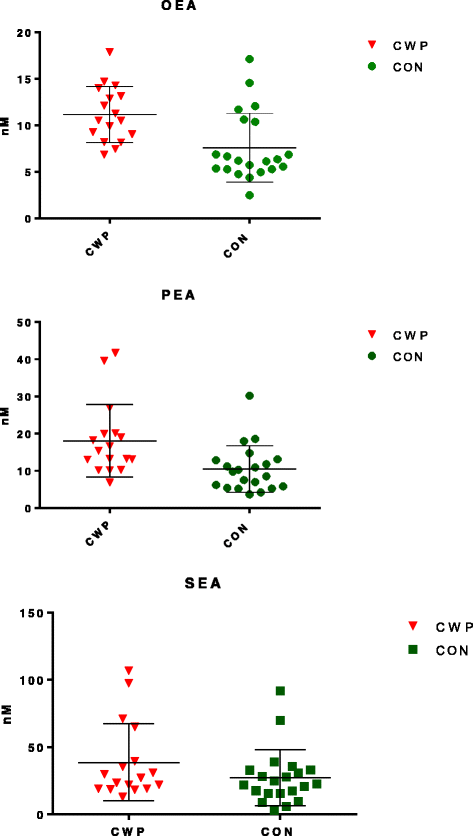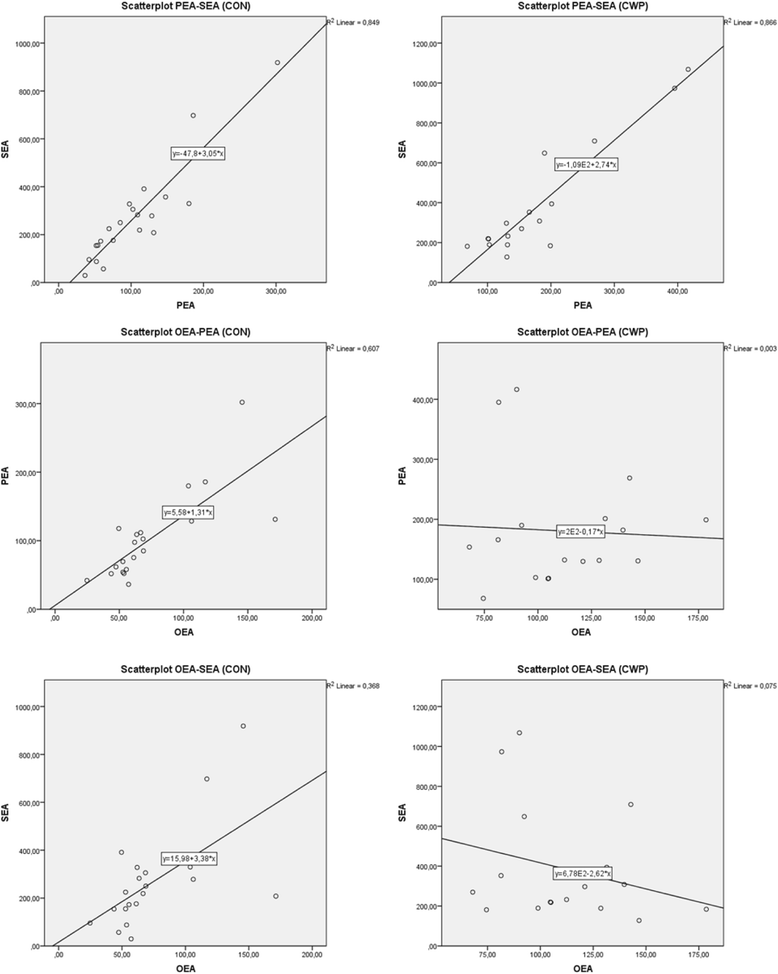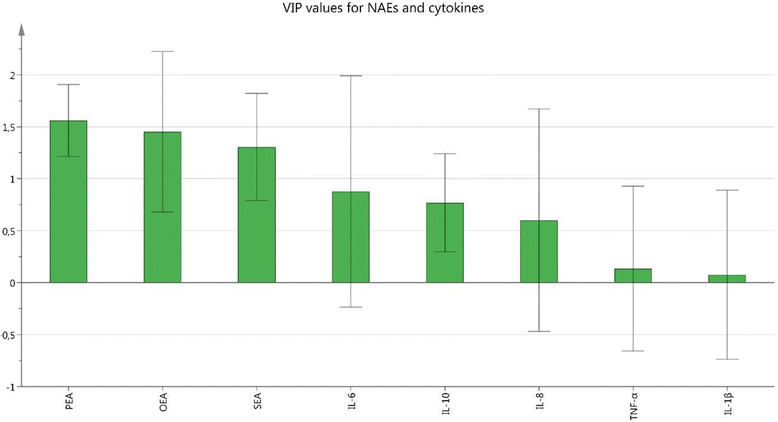Alterations of anti-inflammatory lipids in plasma from women with chronic widespread pain - a case control study
- PMID: 28606089
- PMCID: PMC5469054
- DOI: 10.1186/s12944-017-0505-7
Alterations of anti-inflammatory lipids in plasma from women with chronic widespread pain - a case control study
Abstract
Background: Chronic widespread pain conditions (CWP) such as the pain associated with fibromyalgia syndrome (FMS) are significant health problems with unclear aetiology. Although CWP and FMS can alter both central and peripheral pain mechanisms, there are no validated markers for such alterations. Pro- and anti-inflammatory components of the immune system such as cytokines and endogenous lipid mediators could serve as systemic markers of alterations in chronic pain. Lipid mediators associated with anti-inflammatory qualities - e.g., oleoylethanolamide (OEA), palmitoylethanolamide (PEA), and stearoylethanolamide (SEA) - belong to N-acylethanolamines (NAEs). Previous studies have concluded that these lipid mediators may modulate pain and inflammation via the activation of peroxisome proliferator activating receptors (PPARs) and the activation of PPARs may regulate gene transcriptional factors that control the expression of distinct cytokines.
Methods: This study investigates NAEs and cytokines in 17 women with CWP and 21 healthy controls. Plasma levels of the anti-inflammatory lipids OEA, PEA, and SEA, the pro-inflammatory cytokines TNF-α, IL-1β, IL-6, and IL-8, and the anti-inflammatory cytokine IL-10 were investigated. T-test of independent samples was used for group comparisons. Bivariate correlation analyses, and multivariate regression analysis were performed between lipids, cytokines, and pain intensity of the participants.
Results: Significantly higher levels of OEA and PEA in plasma were found in CWP. No alterations in the levels of cytokines existed and no correlations between levels of lipids and cytokines were found.
Conclusions: We conclude that altered levels of OEA and PEA might indicate the presence of systemic inflammation in CWP. In addition, we believe our findings contribute to the understanding of the biochemical mechanisms involved in chronic musculoskeletal pain.
Keywords: Chronic widespread pain; Cytokines; Inflammation; N-acylethanolamines; Oleoylethanolamide; Palmitoylethanolamide.
Figures



Similar articles
-
Plasma and interstitial levels of endocannabinoids and N-acylethanolamines in patients with chronic widespread pain and fibromyalgia: a systematic review and meta-analysis.Pain Rep. 2022 Nov 7;7(6):e1045. doi: 10.1097/PR9.0000000000001045. eCollection 2022 Nov-Dec. Pain Rep. 2022. PMID: 36381652 Free PMC article. Review.
-
Palmitoylethanolamide and stearoylethanolamide levels in the interstitium of the trapezius muscle of women with chronic widespread pain and chronic neck-shoulder pain correlate with pain intensity and sensitivity.Pain. 2013 Sep;154(9):1649-1658. doi: 10.1016/j.pain.2013.05.002. Epub 2013 May 14. Pain. 2013. PMID: 23707281
-
The Relationship of Endocannabinoidome Lipid Mediators With Pain and Psychological Stress in Women With Fibromyalgia: A Case-Control Study.J Pain. 2018 Nov;19(11):1318-1328. doi: 10.1016/j.jpain.2018.05.008. Epub 2018 Jun 7. J Pain. 2018. PMID: 29885369 Clinical Trial.
-
High levels of endogenous lipid mediators (N-acylethanolamines) in women with chronic widespread pain during acute tissue trauma.Mol Pain. 2016 Aug 16;12:1744806916662886. doi: 10.1177/1744806916662886. Print 2016. Mol Pain. 2016. PMID: 27531672 Free PMC article.
-
Palmitoylethanolamide and other anandamide congeners. Proposed role in the diseased brain.Exp Neurol. 2010 Jul;224(1):48-55. doi: 10.1016/j.expneurol.2010.03.022. Epub 2010 Mar 29. Exp Neurol. 2010. PMID: 20353771 Review.
Cited by
-
CSF levels of apolipoprotein C1 and autotaxin found to associate with neuropathic pain and fibromyalgia.J Pain Res. 2019 Oct 15;12:2875-2889. doi: 10.2147/JPR.S215348. eCollection 2019. J Pain Res. 2019. PMID: 31686904 Free PMC article.
-
Plasma and interstitial levels of endocannabinoids and N-acylethanolamines in patients with chronic widespread pain and fibromyalgia: a systematic review and meta-analysis.Pain Rep. 2022 Nov 7;7(6):e1045. doi: 10.1097/PR9.0000000000001045. eCollection 2022 Nov-Dec. Pain Rep. 2022. PMID: 36381652 Free PMC article. Review.
-
Protective effects of elevated anandamide on stress and fear-related behaviors: translational evidence from humans and mice.Mol Psychiatry. 2020 May;25(5):993-1005. doi: 10.1038/s41380-018-0215-1. Epub 2018 Aug 17. Mol Psychiatry. 2020. PMID: 30120421
-
Fibromyalgia: Associations Between Fat Infiltration, Physical Capacity, and Clinical Variables.J Pain Res. 2022 Aug 27;15:2517-2535. doi: 10.2147/JPR.S376590. eCollection 2022. J Pain Res. 2022. PMID: 36061487 Free PMC article.
-
Role of inflammation in the pathogenesis and treatment of fibromyalgia.Rheumatol Int. 2019 May;39(5):781-791. doi: 10.1007/s00296-019-04251-6. Epub 2019 Feb 13. Rheumatol Int. 2019. PMID: 30756137 Review.
References
MeSH terms
Substances
LinkOut - more resources
Full Text Sources
Other Literature Sources
Medical
Miscellaneous

